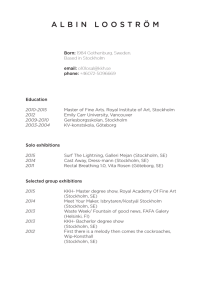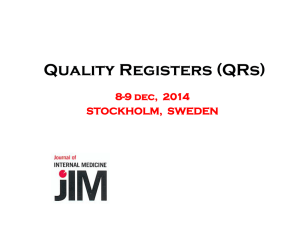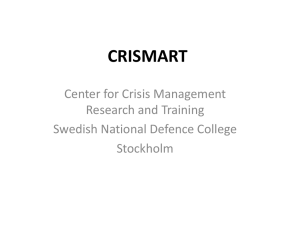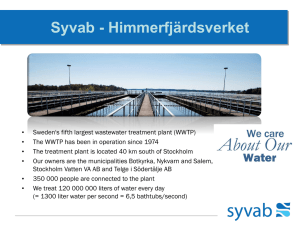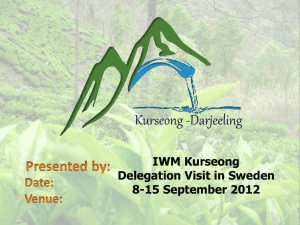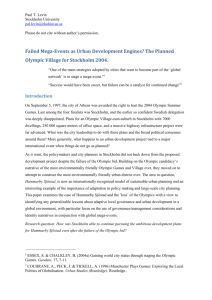Developing a sustainable compact city in
advertisement
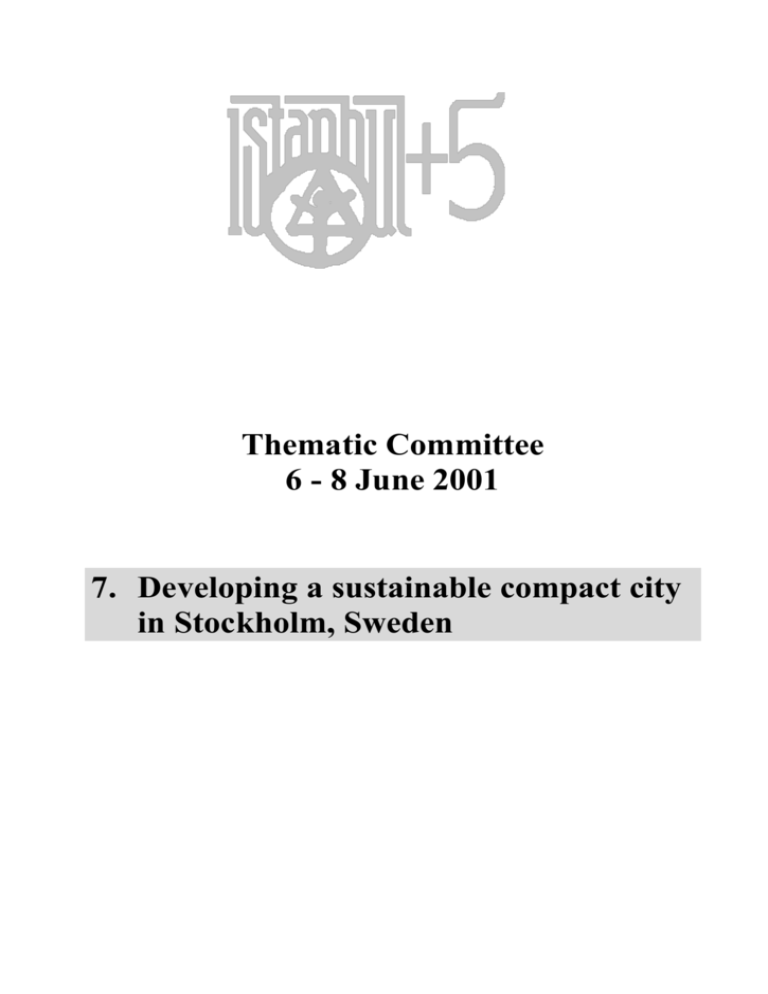
Thematic Committee 6 - 8 June 2001 7. Developing a sustainable compact city in Stockholm, Sweden Developing a sustainable compact city in Stockholm, Sweden. By Mats Pemer Director, Strategic Department, Stockholm City Planning Administration Stockholm is a developing capital city and one of the leading wireless communication cities in the world. Stockholm’s position as a node in the Baltic region is promising for the future regarding the possibilities for development in the eastern parts of that region. Stockholm has a unique character as a city of green and blue – large preserved green areas and blue waters around the islands the city was built on. This unique character is very important as a basis for the future development. It forms a prerequisite for the city, which is, we believe in Stockholm, an important factor when people choose to live and work in our city. But the attractiveness also demands good conditions for business and visitors, for housing and cultural events. Therefore our goal is to continue to develop the city while these unique characters at the same time are preserved and enhanced. A planned city Today’s Stockholm is very much a result of planning efforts and development strategies during the last century. From the 20`s the city took active part in providing people with affordable and decent housing. An important part of the strategy was to buy land for development and also to preserve areas for recreation purposes. The strategy and the planning goals were inspired by modernistic ideals with clear physical separation between dwelling, work and business areas, following the principles of zoning. In the beginning of the 50’s a city-wide comprehensive plan was made that lined out a strategy for the growth of the city. New suburbs were planned along metro lines like pearls on a string. Each suburb was designed as a neighbourhood unit with a social and commercial core, high density housing close to the station, and in the periphery lower density housing together with self-built one-family homes. A green structure was established with green areas and parks dividing the neighbourhoods. Another important part of the strategy to develop a modern liveable city was establishing large-scale systems for heating, sewage and waste treatment. Major investments were made in this field and thanks to them the water today is so clean that you can swim in the middle of the city. Major investments were also made in establishing an efficient public transport system, based on a network of metro lines and commuting trains. The idea was to make it possible for people to live pleasantly in the suburbs and take the metro to work in the city centre or in designated work areas. The planning strategies from the 50’s served the development of Stockholm well during several decades, providing people good housing conditions and a healthy environment. The result was good, but they do not meet today’s needs of developing a sustainable city. 2 Strategy for the 21st century: Build the City inwards Today the city is facing new challenges in creating a modern sustainable city for the next century making it obvious that the old strategies in many ways have become obsolete. There are several reasons for this. The environmental issues came into focus during the later decades of the last century, very much as a result of increasing car traffic. Since the city decided to protect valuable green areas there was little land left possible to develop within the city borders, still the city was growing. Industries moved out from the city and left behind more or less abandoned land. Many of the quickly built large-scale suburban areas from the 60’s and 70’s had developed social and ethnical problems. There are today clear tendencies of an increasing social and ethnic segregation. During the last decades the figures of housing construction have been on a low level, comparing with the figures from the 60’s and 70’s. As a result of this and of the tendencies towards smaller households the demand for new housing is increasing since the 90’s, as is the need for facilities for enterprises mainly in the quickly growing information technology and information businesses. This situation provides opportunities as well as challenges. Obviously there was a need for new planning strategies and as an answer to this Stockholm City Plan 99 was adopted by the City Council in October 1999. A broad discussion among citizens, organisations, local authorities, companies, governmental authorities was part of the process in making the plan. At public meetings and exhibitions all around the city citizens gave their opinion about the plan. The aim of the City Plan 99 is to “build the city inwards”. The new strategy is not to use virgin land for new development, but rather reuse already used land. Today, for one reason or another, lots of land is not as well used as it should be regarding its attractive location close to the inner city or as it constitutes a node for local and regional communications. The City Plan 99 aims at achieving sustainable urban development in accordance with the commitments of the international community reflected in the Habitat Agenda (in particular in its paragraph 43). Urban development areas connected with public transport In the plan a number of urban development areas are pointed out, most of them constituting a circle around and close to the inner city. In these areas the city plans to develop mixed-use areas with attractive housing, business facilities etc. The idea with these urban development areas is to reuse and redevelop old partly abandoned industrial and harbour areas and also take advantage of already existing investments in infrastructure. Several of these urban development areas are or will be connected with a new fast tram system “Tvärbanan” which serves as a connection between the radial metro lines going from the suburbs to the inner city. This tram system is the first effort in Stockholm to establish a peripheral heavy 3 public communication link and it will open new possibilities to develop urban nuclei in the nodes where the tram connects to the metro lines. Environmentally friendly mixed-use urban development The first of these development areas is Hammarby Sjöstad, “Hammarby Sea City”, a new part of inner Stockholm where the focus is on the water. This run-down port and industrial district is being transformed into a modern, ecologically sustainable part of the city. Hammarby Sjöstad is Stockholm’s largest on-going urban development project. An old dockland and industrial area is being transformed into a modern city area that will form a logical extension of Södermalm, with 8, 000 apartments housing a population of 20,000. After completion of all parts of the project in 2010 there will be 30,000 people living and working in the area. Environmentally Hammarby Sjöstad will be a well-planned area with its own recycling model and its own local sewage treatment plant. Hammarby Sjöstad will have an inner-city character with new, exciting architecture, establishing classic urban qualities in a modern shape. Hammarby Sjöstad marks a turn-around from the policy of building suburbs to a policy of reestablishing urban values including streets with shops and restaurants, meeting-places and a mix between work and living. Unique qualities and opportunities flow from the waterside location and the proximity of both the inner city and the Nacka Nature Reserve. In a further response to environmental concerns, Hammarby Sjöstad will be well provided with transportation options including the Tvärbanan tramline, ferries across the Hammarby Canal, and car pooling arrangements. Plans also include a highly developed network of pedestrian and cycling paths. Another quickly developing area within the inner city is Lindhagen City, named after the famous city planner from the late 1800`s. Here some of the most advanced companies within the telecom and internet business sphere are establishing their head offices for the european and nordic markets. Within the area also Pharmacia, one of the worlds largest firms in biotechnology, has one of its most important research facilities. This area will be completed with new housing in an excellent position close to public transport and to the water in the northwestern part. Also in this area there is a stress on establishing urban values. Lindhagen street, now designed as a road for heavy commercial traffic, will be developed as a boulevard. Kista Science City – the “wireless valley” Kista is one of the worlds most important IT-clusters. Firms as Ericsson, Nokia, Intel, Microsoft, Motorola have chosen to locate their development in wireless telecom and wireless Internet to this area. Kista is the result of the 70´s planning activities. It is from the beginning an industrial area, divided from a residential area by a motorway. Parts of this residential area are among the disadvantaged living areas of Stockholm, as are the suburban areas south of Kista. The city is now working with a project to transform these areas to an attractive place for work and life. New physical connections like public transport and roads are important to make the availability better, e g an extension of the Tvärbanan tram line is planned in an effort to overbridge cultural and ethnic barriers existing in the area. Also social and ethnic connections are essential. A co-operative program with job matching between the growing advanced IT-industry in Kista and the housing areas south of it has been successful in providing jobs to unemployed people, mainly immigrants, and providing the firms with competent staff. 4 A landscape park is planned with the aim to knit together the developing Kista area with poorer suburban areas south of it. The idea is to promote social connections. Kista is located in the northwestern parts of Stockholm. It will be designed to be an ecological and cultural park with meeting-places like restaurants and recreation facilities. The development of Kista is very important also for the development of the surrounding municipalities. It is essential to establish planning in co-operation between several municipalities and also in close dialogue with different interests and the inhabitants in the area. Such cooperation has started looking at developing new public transport within this greater area. Creating a network region for work and life Stockholm has in international comparison good figures regarding the modal split. 70% of the people travelling to work from the suburbs to the inner city use public transport during rush hours. This is a result of the investments in public transport and also subsidies to keep down fares. The aim is to keep that figure and if possible make it even better, which is a real challenge regarding the fact that the number of private cars are increasing. To do so we believe that it is essential to develop quite concentrated areas, mixed-use, close to public transport, which makes the use of private cars unnecessary and inconvenient. A further spread of the urban sprawl is not positive from a point of view of sustainability. On the other hand a network of fast regional and commuting trains make it possible to develop a multicore network region of smaller and bigger towns and cities around the Mälar Valley, wich is the larger region of Stockholm, comprising three or four counties. Developing a multi-core region served by a train system like this could make it possible to avoid further development of edge cities served by cars. This train network is under development. The first part, the Svealandsbanan, which knits together towns like Eskilstuna, Strängnäs and Södertälje with Stockholm, is a great success. The railway makes it convenient to travel daily the110 kilometres from Eskilstuna to Stockholm. The passenger figures are widely over the prognoses. And, the car traffic on the motorway parallell with the railroad is decreasing. The success for the new train routes points to further railway development. The “European Corridor” is a project maintained in co-operation between nearly forty cities, municipalities and regions in southern Sweden, eastern Denmark and northern Germany for a high-speed railway from Stockholm via Copenhagen to Hamburg. This high-speed railway constitutes a backbone in a mega-region where about 5 million people live in the Swedish part. The high-speed railway is the main part in a system of inter-city, regional and local trains that connect the different submarkets in the whole region. It will play an important role in connecting the Baltic area with the northern parts of the European Continent. It is essential to maintain and develop environmentally sound, sustainable, cheap and effective transports which are necessary for the development of the Northern Europe region. We are convinced that in today’s IT-era the demand for personal meetings will rather increase than decrease. 5 Preserving and developing the green structure Unlike many other metropolitan regions, Stockholm has retained a great deal of its natural and cultural landscape. The waterways, Lake Mälaren and the inner archipelago of the Baltic Sea, contribute to the city’s character as do the green open land areas and greenways, all over present in the city and integrated into the built-up environments. The green structure is important for health and recreation of people living in Stockholm; it allows us to experience natural qualities and scenic beauty in the city, caters for a rich flora and fauna, creates a good urban climate and provides a basis for a sustainable city. Stockholm City Plan and the Green Map have been parallel projects. On the basis of the guidelines of Stockholm City Plan, the Green Map goes further and defines the green qualities for the Inner City Area as well as the suburbs. The Green Map defines the values of parks and green areas. It is divided into an ecological part, based on a biotop mapping showing biodiversity, and a socio-cultural part based on a ”sociotop map” which is the result of a communicative process involving citizens. A ”sociotop” can be defined as ”a place for human activities and experience ”. Participation in enhancing suburban areas According to the national planning legislation there are clear rules how to manage consultations during the planning process with people concerned of a planning project. Stockholm has a tradition since several decades of dialogue and discussions with the inhabitants about planning issues. This dialogue process needs continuing development to enhance democracy and the citizen’s engagement. In the late sixties and early seventies suburbs were built as a part of the national "million programme" according to which one million new apartments were to be built in Sweden during a period of ten years. The objective was to get rid of the still heavy housing shortage, and generous governmental housing subsidies financed it. Suburbs with large-scale apartment houses were built along metro lines. The local environment was often poor. On the other hand the flats had excellent standards regarding space and contained all technical equipment you could need. In the seventies many of these large-scale suburbs were drained from tenants who were able to move to own houses. This lead to empty flats, economic problems for the housing companies and a growing social and ethnical segregation. Moreover it was soon obvious that the building quality of the quick-built high-rises was not too good. Upon that the large unemployment in the nineties has lead to increasing social problems in the "million programme" areas. With the aim to solve social and ethnic problems in large-scale suburbs the City manages the Outer City Programme in co-operation with the tenants, supporting them in their own efforts to improve their situation. A result is that the built environment and the design and standards of the buildings has been largely improved following tenants initiatives. Stress has also been put on education and job matching in co-operation with companies to improve the inhabitants’ situation with some good results. 6 Environment and democracy During the autumn of 2000 a number of round-table discussions were held with environmental organisations, construction companies, building administrators, road users, young people, local residents and corporations. The objective was to identify the views of city residents and certain strategic groupings as to how Stockholm, by applying a new Environmental Programme, could work towards sustainable development while at the same time opening up new channels for continuos dialogue. During these talks participants were asked to express their own opinion based on personal experience. As a result of this process, certain aspects have emerged as a number of areas that are of central concern to the inhabitants of Stockholm. Resources must be handled more efficiently. Travel and transportation must be adapted to environmental needs. Food must be healthy and wholesome. Green areas within the city must be protected. The local infrastructure must be suited all forms of traffic. This reflexes thoughts and wishes of Stockholm inhabitants and will be an important input to the ongoing work with the environmental programme. Since public awareness of environmental issues has grown, it is no longer sufficient to consider environmental issues solely from the viewpoint of the administration. Certain aspects of the environmental programme call for active participation by the inhabitants themselves. 7


